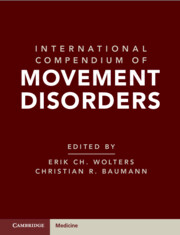Book contents
- International Compendium of Movement Disorders
- International Compendium of Movement Disorders
- Copyright page
- Contents
- Contributors
- International Compendium of Movement Disorders
- Hypo- and Hyperkinetic, Dyscoordinative and Otherwise Inappropriate Motor and Behavioral Movement Disorders
- Section 1: Basic Introduction
- Section 2: Hypokinetic Movement Disorders
- Section 3: Hyperkinetic Movement Disorders
- Section 4: Dyscoordinative and Otherwise Inappropriate Motor Behaviors
- Section 5: Objectifying Movement Disorders
- Movement Disorders in Vivo: Video Fragments
- Acronyms and Abbreviations
- Index
Hypo- and Hyperkinetic, Dyscoordinative and Otherwise Inappropriate Motor and Behavioral Movement Disorders
Published online by Cambridge University Press: 07 January 2025
- International Compendium of Movement Disorders
- International Compendium of Movement Disorders
- Copyright page
- Contents
- Contributors
- International Compendium of Movement Disorders
- Hypo- and Hyperkinetic, Dyscoordinative and Otherwise Inappropriate Motor and Behavioral Movement Disorders
- Section 1: Basic Introduction
- Section 2: Hypokinetic Movement Disorders
- Section 3: Hyperkinetic Movement Disorders
- Section 4: Dyscoordinative and Otherwise Inappropriate Motor Behaviors
- Section 5: Objectifying Movement Disorders
- Movement Disorders in Vivo: Video Fragments
- Acronyms and Abbreviations
- Index
Summary
Behavior is considered the response to internal and external stimuli. Both the basal ganglia as well as the cerebellum process internal (homeostatic) and external (environmental) cortical information in order to orchestrate adequately adapted behavior and send this processed information via the thalamus back to the cortex for final execution through motor neurons and neuromuscular structures. The basal ganglia arrange for the appropriate selection of behavioral fragments (response selection) out of the available pool of learned standard behaviors, and define their magnitude, while the cerebellum together with the sensory, visual, and vestibular organs deal with their coordination, that is, the exact timing of muscle actions so that the body can move smoothly. The final execution of these movements is enabled by upper/lower motor neurons and neuromuscular structures.
- Type
- Chapter
- Information
- International Compendium of Movement Disorders , pp. 1 - 4Publisher: Cambridge University PressPrint publication year: 2025

